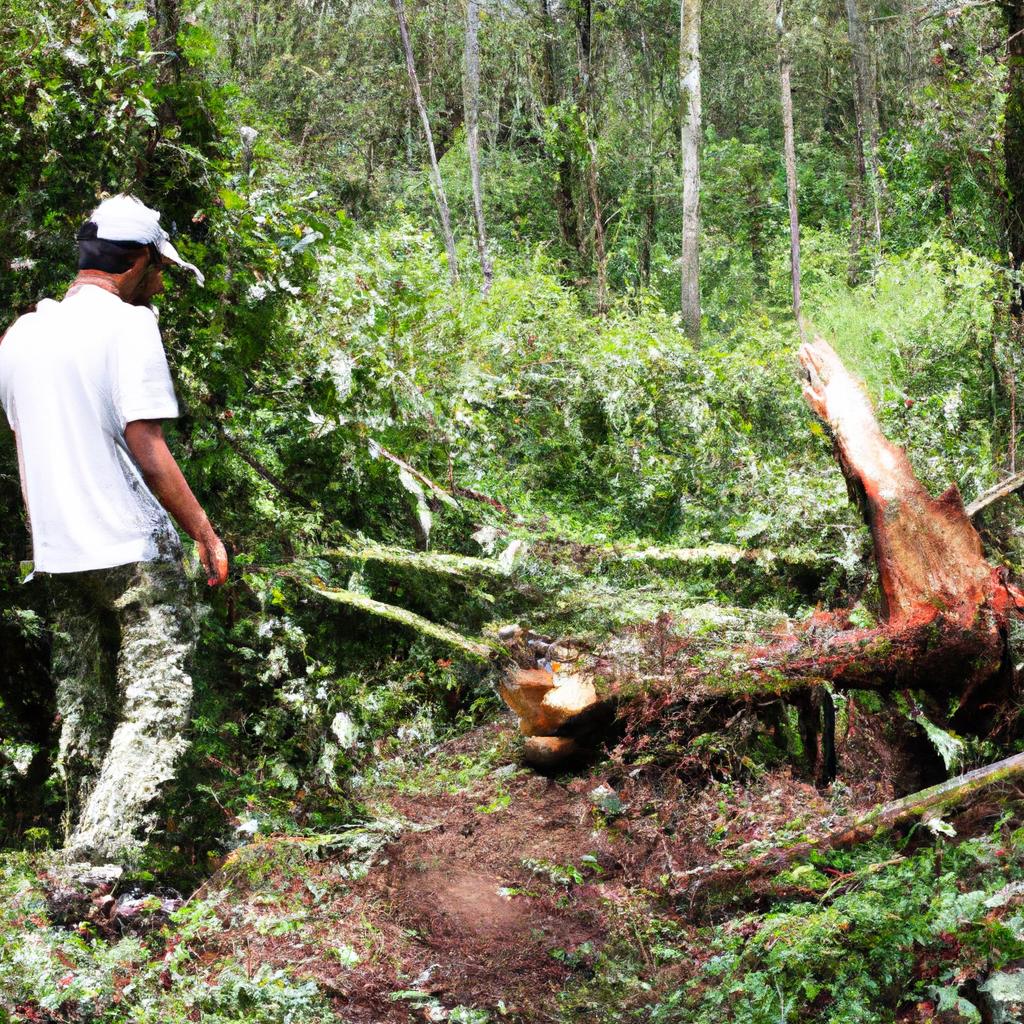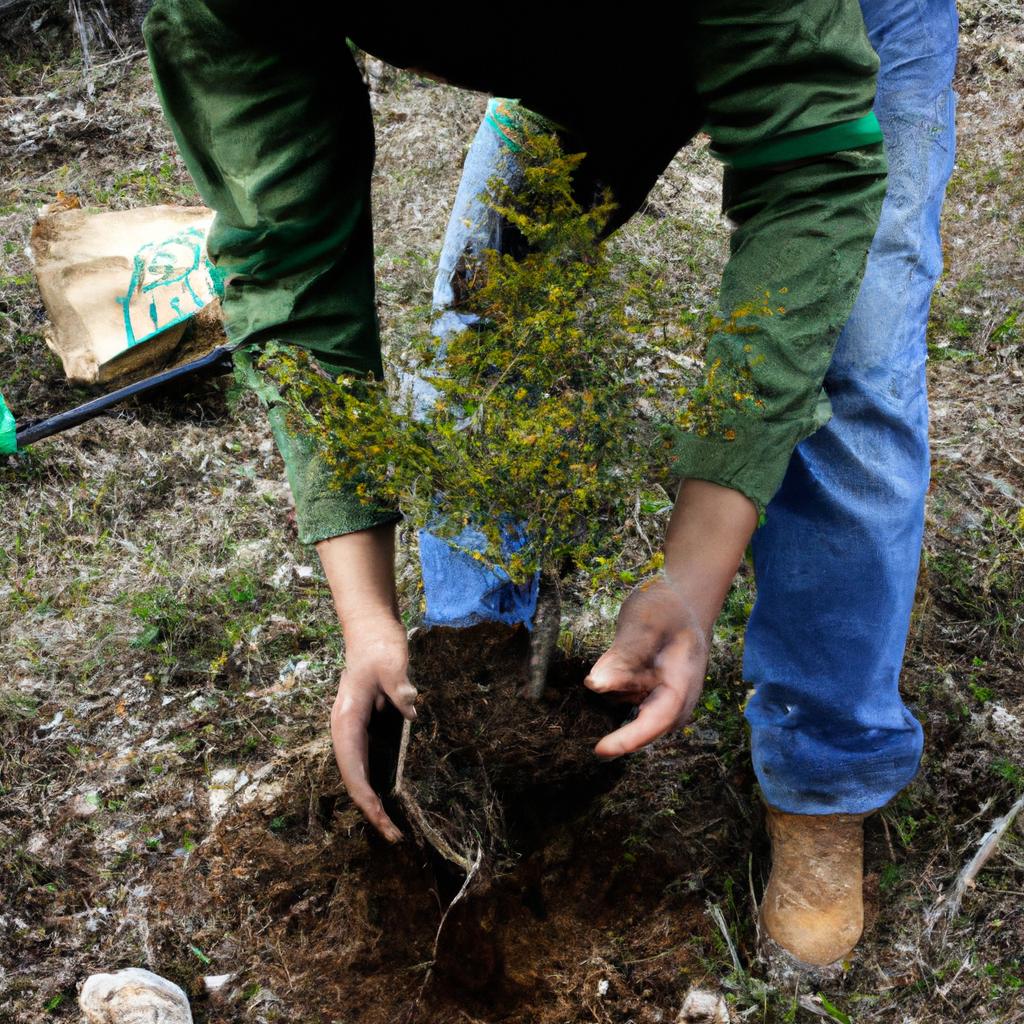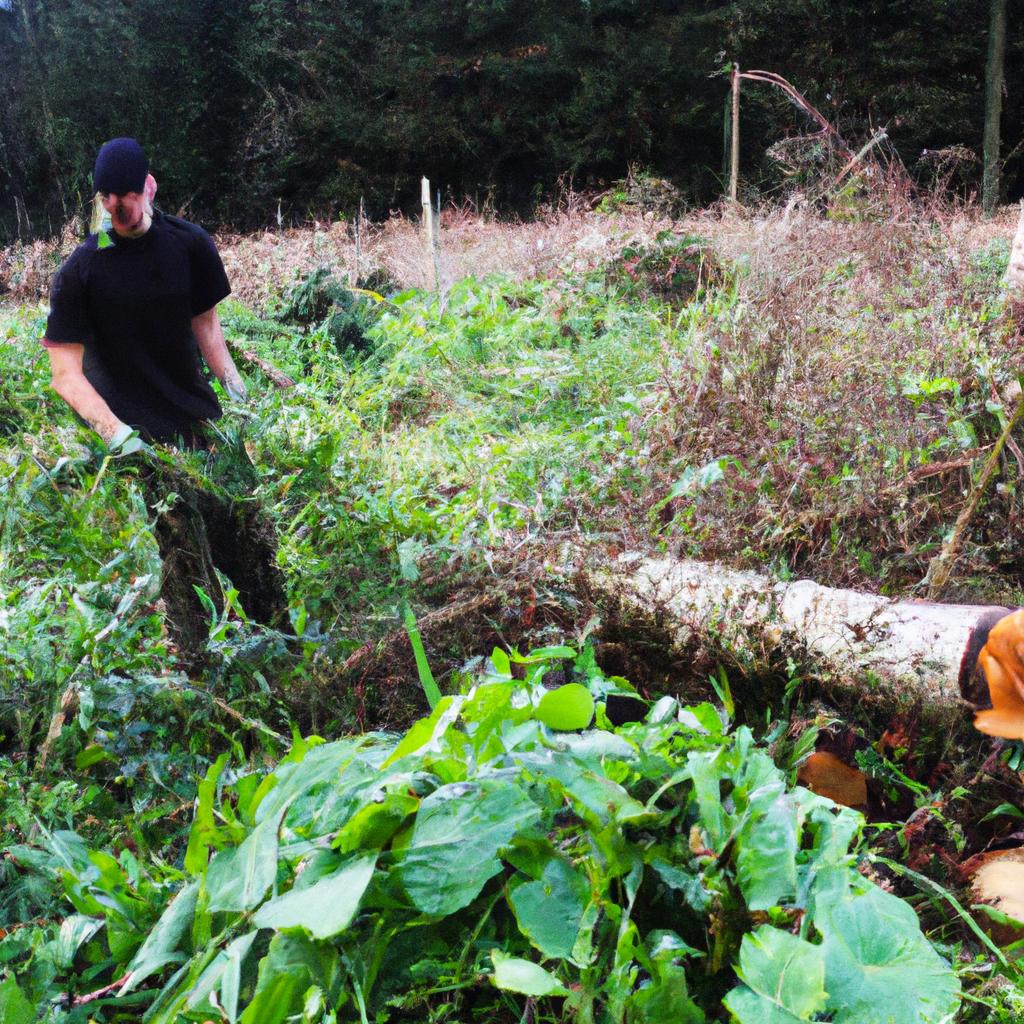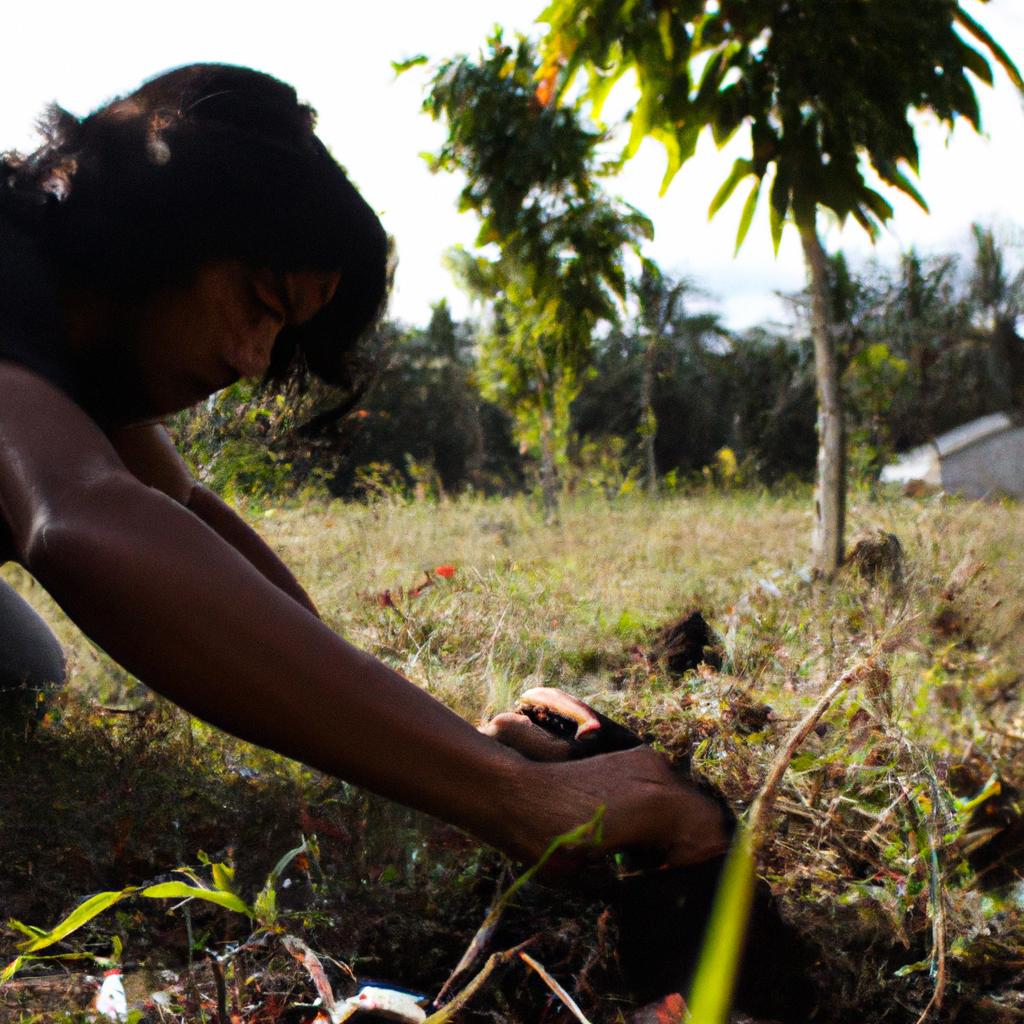The management of forests is a critical aspect for both business agriculture and forestry sectors, as it plays a vital role in ensuring the sustainability and long-term viability of these industries. Forest management planning involves the strategic decision-making process that guides the utilization, conservation, and restoration efforts within forested areas. This article explores various sustainable strategies employed in forest management planning, with a focus on their relevance and impact on business agriculture and forestry.
For instance, consider a hypothetical case study where an agricultural company owns vast tracts of land containing valuable timber resources. Without proper management practices, such as clear-cutting or over-harvesting, this company could exhaust its timber supply quickly while simultaneously degrading the ecosystem services provided by the surrounding forest. Thus, effective forest management planning becomes imperative to strike a balance between economic gain and environmental stewardship.
This article aims to delve into the key principles underlying sustainable forest management planning for business agriculture and forestry sectors. By examining different approaches like selective logging, reforestation initiatives, and biodiversity conservation measures, we seek to highlight how these strategies can promote not only ecological integrity but also contribute to socio-economic development. Additionally, we will explore some challenges faced by businesses and policymakers in implementing sustainable forest management plans and discuss potential solutions for overcoming them .
One of the key principles underlying sustainable forest management planning is the practice of selective logging. Selective logging involves carefully selecting and harvesting specific trees while leaving the majority of the forest intact. This approach helps to maintain the overall structure and biodiversity of the forest, as well as minimize soil erosion and damage to wildlife habitats. By implementing selective logging practices, businesses in the agriculture and forestry sectors can ensure a sustainable supply of timber while preserving the long-term health of the ecosystem.
Reforestation initiatives are another important strategy in sustainable forest management planning. After harvesting trees, replanting efforts can help restore forests to their original state or establish new ones in degraded areas. Reforestation not only contributes to carbon sequestration but also provides valuable habitat for wildlife, improves water quality, and supports local economies by providing jobs and resources.
Biodiversity conservation measures are also crucial components of sustainable forest management planning. Protecting endangered species, conserving rare habitats, and promoting ecological resilience are all essential for maintaining a healthy and diverse forest ecosystem. Businesses and policymakers can implement measures such as creating protected areas within their land holdings, establishing wildlife corridors, and adopting sustainable harvesting practices that minimize impacts on biodiversity.
However, implementing sustainable forest management plans in business agriculture and forestry sectors comes with challenges. One common challenge is balancing short-term economic gains with long-term sustainability objectives. Some companies may prioritize maximizing profits over environmental stewardship, which can lead to unsustainable practices like excessive deforestation or degradation of ecosystems.
Another challenge is ensuring effective governance and enforcement of regulations related to forest management planning. Weak regulatory frameworks or lack of monitoring mechanisms can undermine sustainability efforts and allow illegal activities such as logging or poaching to persist.
To overcome these challenges, it is crucial for businesses and policymakers to adopt a multi-stakeholder approach that involves collaboration between government agencies, local communities, NGOs, and industry representatives. By engaging all relevant stakeholders in decision-making processes, transparency can be ensured, and the interests of all parties can be taken into account.
Furthermore, promoting awareness and education about the importance of sustainable forest management is essential. By informing stakeholders about the benefits of sustainable practices and providing training on best management techniques, businesses can foster a culture of responsible stewardship within their organizations.
In conclusion, sustainable forest management planning is vital for ensuring the long-term viability of business agriculture and forestry sectors. By implementing strategies such as selective logging, reforestation initiatives, and biodiversity conservation measures, companies can strike a balance between economic gain and environmental stewardship. However, challenges such as balancing short-term profits with long-term sustainability goals and enforcing regulations must be addressed through multi-stakeholder approaches and increased awareness. Ultimately, by adopting sustainable forest management practices, businesses can contribute to both ecological integrity and socio-economic development.
Understanding the Importance of Forest Management
Forest management plays a crucial role in ensuring the sustainable utilization and conservation of forest resources. Effective forest management strategies are essential for maintaining ecological balance, preserving biodiversity, and meeting socio-economic needs. To illustrate this significance, consider the case study of a timber company that implemented sustainable forest management practices. By adopting responsible logging techniques, such as selective cutting and reforestation efforts, they were able to maintain long-term profitability while safeguarding the health of the forest ecosystem.
To fully grasp the importance of forest management, it is necessary to recognize its multifaceted benefits. Firstly, well-managed forests provide habitat for numerous plant and animal species, fostering biodiversity preservation. Additionally, these ecosystems act as carbon sinks, sequestering significant amounts of CO2 from the atmosphere and mitigating climate change impacts. Moreover, sustainable forestry practices contribute to watershed protection by preventing soil erosion and promoting water quality. Lastly, forests offer recreational opportunities such as hiking trails or camping sites which can boost local tourism economies.
Consider the following bullet points highlighting some key advantages derived from effective forest management:
- Conservation: Protects endangered species and preserves natural habitats.
- Climate Change Mitigation: Facilitates carbon storage and reduces greenhouse gas emissions.
- Water Resources: Sustains clean drinking water sources and regulates hydrological cycles.
- Socio-economic Benefits: Supports rural livelihoods through job creation and economic development.
In addition to these benefits, successful forest management requires comprehensive assessment frameworks to evaluate current conditions accurately. This entails analyzing various aspects including tree density, age distribution, biodiversity levels, soil fertility status, pest infestation rates, and potential risks associated with natural disasters. By carefully evaluating these parameters within a systematic framework guided by scientific principles and stakeholder input, informed decisions regarding resource allocation can be made.
Transitioning into the subsequent section on “Assessing Current Forest Conditions and Resources,” understanding the importance of sound forest management lays the foundation for effective planning and decision-making processes. By comprehending the ecological, economic, and social significance of forests, managers can develop strategies that ensure long-term sustainability while meeting the needs of multiple stakeholders.
Next section: Assessing Current Forest Conditions and Resources
Assessing Current Forest Conditions and Resources
Building upon the understanding of the importance of forest management, it is crucial to assess the current conditions and available resources within a forest ecosystem. This assessment provides valuable insights into potential challenges and opportunities for sustainable strategies in forestry practices. To illustrate this point, let us consider a hypothetical case study involving a diverse forest region facing threats from illegal logging.
In order to comprehensively evaluate the current state of a forest, several factors must be considered:
-
Biodiversity Assessment:
- Conduct surveys to identify and document plant and animal species.
- Determine their abundance and distribution patterns.
- Evaluate the presence of endangered or invasive species that might impact biodiversity.
-
Soil Analysis:
- Analyze soil composition and nutrient levels.
- Assess soil erosion rates and potential degradation risks.
- Identify areas requiring remediation measures such as reforestation or erosion control.
-
Timber Inventory:
- Estimate timber volume through sample plots or remote sensing techniques.
- Determine tree age structure, growth rates, and species diversity for sustainable harvesting plans.
-
Socio-Economic Evaluation:
- Consider local communities’ dependence on forests for livelihoods.
- Assess economic benefits derived from non-timber forest products (NTFPs) like medicinal plants or ecotourism activities.
- Gauge potential social impacts arising from changes in forest management policies.
Table: Economic Benefits Derived from Non-Timber Forest Products (NTFPs)
| NTFP Category | Economic Benefit | Example Usage |
|---|---|---|
| Medicinal Plants | Revenue from sales | Herbal medicine production |
| Wild Fruits | Income generation | Processing into jams, jellies, or dried snacks |
| Handicrafts | Livelihood support | Production of baskets, woven mats, or wood carvings |
| Ecotourism | Tourist expenditure | Guided nature walks, camping, or bird watching |
In light of the assessment findings and considering the hypothetical case study mentioned above, forest managers can make informed decisions regarding sustainable strategies that align with ecological conservation and socio-economic development. By understanding current forest conditions and available resources, they are better equipped to design management plans that address threats, preserve biodiversity, promote local livelihoods, and optimize timber harvest levels.
With a comprehensive assessment in hand, the next step is to set clear goals and objectives for effective forest management. This requires careful consideration of long-term sustainability principles while accommodating economic interests and societal needs without compromising future generations’ ability to meet their own requirements.
Setting Clear Goals and Objectives for Forest Management
In order to effectively manage a forest, it is crucial to first assess its current conditions and available resources. By gaining an understanding of the existing state of the forest, landowners and managers can make informed decisions regarding future management strategies. This section will explore various methods for assessing forest conditions and resources, providing insights into their importance in developing sustainable forest management plans.
To illustrate the significance of this assessment process, let us consider a hypothetical case study involving an industrial timber company operating in a large forested area. The company’s primary objective is to optimize timber production while ensuring ecological sustainability. Before implementing any management activities, they must evaluate the health and composition of the forest ecosystem they are working with.
Several key factors should be considered when assessing current forest conditions:
- Biodiversity: A diverse range of plant and animal species contributes to a healthy ecosystem. Assessing biodiversity helps identify potential risks or imbalances that may need attention.
- Soil Quality: Healthy soils provide essential nutrients for plant growth and help maintain water quality. Evaluating soil characteristics provides valuable information on fertility levels and possible nutrient deficiencies.
- Tree Age Structure: Understanding the distribution of tree ages within a forest allows for better planning and ensures adequate regeneration by considering seed source availability.
- Threats and Risks: Identifying potential threats such as invasive species, disease outbreaks, or natural disasters enables proactive measures to mitigate these risks.
To further emphasize the importance of this assessment stage, consider Table 1 below which presents data from a real-life research project evaluating different aspects of a managed forest:
Table 1: Assessment Findings in Managed Forest Area
| Aspect | Finding |
|---|---|
| Biodiversity | High diversity observed |
| Soil Quality | Moderate fertility levels |
| Tree Age Structure | Imbalanced age classes |
| Threats/Risks | Increased pest activity |
These findings highlight the need for targeted management actions, such as promoting natural regeneration and implementing pest control measures. By assessing current forest conditions, landowners can make informed decisions to ensure long-term sustainability.
In moving forward with forest management planning, it is crucial to set clear goals and objectives based on the assessment results. The next section will delve into this aspect of the process by exploring how these goals contribute to developing sustainable strategies for long-term forest health.
Transitioning into the subsequent section about “Developing Sustainable Strategies for Long-Term Forest Health,” we shift our focus from evaluating current conditions to utilizing that knowledge in setting meaningful goals and objectives.
Developing Sustainable Strategies for Long-Term Forest Health
Building on the foundation of clear goals and objectives for forest management, developing sustainable strategies is crucial to ensure long-term forest health. By implementing strategic approaches, businesses in agriculture and forestry can effectively balance economic growth with environmental conservation. To illustrate this concept, let’s consider a hypothetical case study of a timber company that aims to optimize its operations while minimizing negative impacts on the ecosystem.
In order to develop sustainable strategies for long-term forest health, several key considerations must be taken into account:
-
Biodiversity preservation: The first step towards sustainability involves understanding the diverse ecological components within the forest ecosystem. This includes identifying endangered species, flora and fauna habitats, and creating plans to protect them during logging activities.
-
Soil conservation: Forest soils play a vital role in maintaining overall ecosystem health. Implementing practices such as controlled harvesting techniques, reforestation programs, and erosion control measures can help minimize soil degradation and promote healthy regrowth.
-
Carbon sequestration: Forests are essential carbon sinks that absorb greenhouse gases from the atmosphere. Developing strategies to enhance carbon sequestration through proper tree planting methods, promoting natural regeneration processes, and reducing deforestation rates contribute significantly towards mitigating climate change.
-
Community engagement: Engaging local communities in forest management planning fosters collaboration between stakeholders. This involvement ensures their needs are accounted for while aligning business interests with social responsibility. It also creates opportunities for shared benefits like eco-tourism or non-timber forest products.
To further emphasize the importance of these sustainable strategies for long-term forest health, we present a table showcasing some potential positive outcomes associated with their implementation:
| Sustainable Strategy | Positive Outcomes |
|---|---|
| Biodiversity Preservation | Enhanced habitat protection |
| Soil Conservation | Reduced soil erosion |
| Carbon Sequestration | Decreased carbon emissions |
| Community Engagement | Improved social and economic welfare |
By adopting these strategies, businesses can effectively manage their forests while preserving biodiversity, conserving soil health, mitigating climate change, and promoting community well-being. Implementing effective forest management practices is the next essential step towards achieving sustainable outcomes for both business agriculture and forestry.
As we move forward into the subsequent section on implementing effective forest management practices, it becomes evident that taking a proactive approach to conservation is critical in ensuring the continued success of sustainable forestry operations.
Implementing Effective Forest Management Practices
To illustrate the importance of sustainable strategies in forest management planning, let us consider a hypothetical case study. Imagine a dense forest located near a small town that has been experiencing significant deforestation due to logging activities. The local community relies heavily on the forest for their livelihoods, including timber production and ecotourism. Recognizing the need for long-term forest health, stakeholders come together to develop sustainable strategies that will ensure the continued viability of the forest ecosystem.
One key aspect of developing sustainable strategies is promoting biodiversity conservation. By maintaining a diverse range of plant and animal species within the forest, ecosystems are more resilient to disturbances such as diseases or climate change events. This can be achieved through implementing measures like habitat restoration and protection, reducing invasive species, and creating wildlife corridors to facilitate movement between fragmented habitats.
Another crucial element of sustainable forestry practices is ensuring responsible harvesting methods. Implementing selective cutting techniques instead of clear-cutting helps preserve tree diversity and allows for natural regeneration processes to take place effectively. Additionally, integrating agroforestry systems into forest management plans can provide economic benefits while minimizing environmental impacts by combining agricultural crops with strategically planted trees.
Sustainable strategies also involve engaging local communities and fostering social responsibility towards forests. Educating residents about the value of forests and involving them in decision-making processes promotes ownership and stewardship over natural resources. This can be achieved through initiatives such as community-based monitoring programs, where locals actively participate in data collection related to forest health indicators.
Emphasizing these principles in forest management planning not only ensures long-term ecological sustainability but also brings numerous socio-economic benefits to both local communities and businesses reliant on the forest ecosystem’s services.
| Benefits | Community Involvement | Biodiversity Conservation | Responsible Harvesting |
|---|---|---|---|
| Economic stability | Increased awareness | Ecosystem resilience | Sustainable resource use |
| Enhanced quality of life | Empowerment of local residents | Protection of endangered species | Preservation of forest structure |
| Tourism opportunities | Participatory decision-making | Mitigation of climate change impacts | Regeneration and succession processes |
| Environmental protection | Sense of ownership and stewardship | Promotion of natural regeneration | Minimization of ecological disturbance |
As we have seen, developing sustainable strategies for long-term forest health involves promoting biodiversity conservation, responsible harvesting methods, and fostering community involvement. In the following section on “Monitoring and Evaluating the Success of Forest Management Plans,” we will explore how to assess the effectiveness of these strategies in ensuring the desired outcomes while providing guidance for future improvements.
Monitoring and Evaluating the Success of Forest Management Plans
Section Title: Evaluating the Impact of Forest Management Plans
Building upon effective forest management practices, it is crucial to monitor and evaluate the success of implemented plans. This ensures that sustainable strategies are being effectively executed and any necessary adjustments can be made in order to achieve desired outcomes.
Paragraph 1:
To illustrate the importance of monitoring and evaluation, let us consider a hypothetical case study involving a timber company implementing a forest management plan aimed at preserving biodiversity while also maintaining their economic viability. By regularly assessing key indicators such as tree density, species composition, soil quality, and wildlife population dynamics, the company can gain valuable insights into the effectiveness of their conservation efforts. For instance, if they observe an increase in rare or endangered species within their managed forests over time, this would indicate positive progress towards achieving their sustainability goals.
Paragraph 2:
To facilitate systematic assessment of forest management plans, here are four essential steps for evaluating their impact:
- Establishing Baseline Data: Collecting comprehensive data on ecological factors before implementing any management interventions provides a reference point against which future changes can be compared.
- Regular Monitoring: Implementing ongoing monitoring protocols enables tracking of key variables over time to identify trends and potential issues early on.
- Analysis and Interpretation: Proper analysis and interpretation of collected data allows for informed decision-making regarding adjustment or continuation of current practices.
- Stakeholder Engagement: Involving relevant stakeholders throughout the evaluation process fosters transparency, accountability, and collaboration among all parties involved.
The benefits of robust monitoring and evaluation systems include:
- Ensuring long-term environmental sustainability
- Enhancing ecosystem resilience
- Preserving biodiversity hotspots
- Promoting responsible resource use
Paragraph 3:
In addition to these steps, utilizing visual aids like tables can enhance comprehension by providing concise summaries of complex information. The table below offers an example framework for evaluating the impact of forest management plans based on various parameters:
| Parameter | Measurement Method | Target Value | Current Status |
|---|---|---|---|
| Tree Density | Point Sampling | 800 trees per hectare | 780 trees per hectare |
| Species Composition | Transect Surveys | ≥50% native species | 60% native species |
| Soil Quality | Soil Analysis | pH range: 5.5-6.5 | pH: 6.2 |
| Wildlife Population | Camera Trapping | Stable or increasing | Increasing |
By regularly updating and analyzing such a table, forest managers can compare target values with current status, identify areas that require attention, and implement appropriate measures to address any gaps.
In summary, monitoring and evaluating the success of forest management plans is essential for ensuring their effectiveness in achieving sustainable outcomes. By establishing baseline data, implementing regular monitoring protocols, engaging stakeholders, and utilizing visual aids like tables, organizations can optimize their strategies for long-term environmental sustainability while addressing economic objectives without compromising biodiversity conservation efforts. Continuous assessment allows for adaptation and improvement over time, reinforcing responsible practices within the forestry sector.




